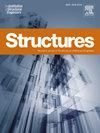预应力钢绞线锚固界面接触特性表征锚固下应力
IF 4.3
2区 工程技术
Q1 ENGINEERING, CIVIL
引用次数: 0
摘要
预应力钢绞线的受力状态评估是目前评估预应力结构体系安全性和寿命的主要依据。针对目前预应力梁桥中钢绞线预应力检测技术缺乏的问题,本研究通过实验研究了锚固接触界面(特别是多孔锚固与锚板接触界面,MHA-ABP界面)与超声信号的相互作用。此外,建立了MHA-ABP界面接触特性与界面压力之间的关系。然后用1股和7股钢绞线对MHA-MHA界面进行了进一步的测试,以研究低应力和高应力条件下MHA-MHA界面的接触特性。结果表明:MHA-ABP和MHA-MHA界面的反射系数和非线性刚度与界面压力呈非线性递减关系(RMHA-MHA/ RMHA-ABP≈1/2.8,K1, MHA-MHA/K1, MHA-ABP≈2.45);此外,线刚度和界面压力遵循幂律函数的理论模型。反射系数、线性刚度和非线性刚度随界面压力的增大而趋于稳定。这三个指标与界面压力之间存在很强的相关性,从而可以有效地响应钢绞线中的应力变化。这种相关性有助于克服由于钢绞线边界和其他条件的限制而导致的检测结果准确性低的问题。本文章由计算机程序翻译,如有差异,请以英文原文为准。
Characterization of stresses under anchor in prestressing steel strands by contact properties at the anchorage interface
The assessment of the stress state of prestressed steel strands is currently the primary basis for assessing the safety and longevity of prestressed structural systems. In response to the existing lack of efficient techniques for detecting prestressing of steel strands in prestressed girder bridges, the interaction between the anchorage contact interface (specifically the contact interface between the multi-hole anchorage and the anchor bearing plate, MHA-ABP interface) and the ultrasonic signal is investigated experimentally in this study. In addition, the relationship between the contact characteristics of the MHA-ABP interface and the interface pressure is established. Further tests were then carried out on the MHA-MHA interface with one and seven steel strands to investigate the contact characteristics of the MHA-MHA interface under low and high stress conditions. The results show that the reflection coefficient and the non-linear stiffness of the MHA-ABP and MHA-MHA interfaces exhibit a non-linear decreasing correlation with the interface pressure (RMHA-MHA/ RMHA-ABP ≈ 1/2.8, K1, MHA-MHA/K1, MHA-ABP ≈ 2.45). Furthermore, linear stiffness and interface pressure follow the theoretical model of a power-law function. The reflection coefficient, linear stiffness and non-linear stiffness show a stabilization with increasing interface pressure. There is a strong correlation between these three indicators and the interface pressure, allowing an effective response to stress variations in the steel strand. This correlation helps to overcome the problem of low accuracy of detection results caused by limitations imposed by the steel strand boundary and other conditions.
求助全文
通过发布文献求助,成功后即可免费获取论文全文。
去求助
来源期刊

Structures
Engineering-Architecture
CiteScore
5.70
自引率
17.10%
发文量
1187
期刊介绍:
Structures aims to publish internationally-leading research across the full breadth of structural engineering. Papers for Structures are particularly welcome in which high-quality research will benefit from wide readership of academics and practitioners such that not only high citation rates but also tangible industrial-related pathways to impact are achieved.
 求助内容:
求助内容: 应助结果提醒方式:
应助结果提醒方式:


